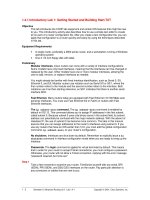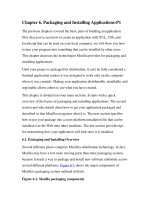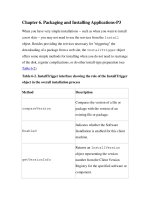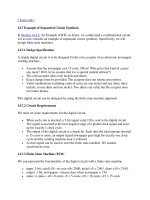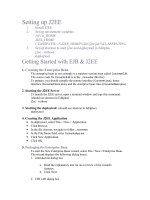Tài liệu Getting Started with Citrix XenApp 6.5 ppt
Bạn đang xem bản rút gọn của tài liệu. Xem và tải ngay bản đầy đủ của tài liệu tại đây (14.99 MB, 478 trang )
Getting Started with Citrix
XenApp 6.5
Design and implement Citrix farms based on
XenApp 6.5
Guillermo Musumeci
P U B L I S H I N G
professional expertise distilled
BIRMINGHAM - MUMBAI
Getting Started with Citrix XenApp 6.5
Copyright © 2012 Packt Publishing
All rights reserved. No part of this book may be reproduced, stored in a retrieval
system, or transmitted in any form or by any means, without the prior written
permission of the publisher, except in the case of brief quotations embedded in
critical articles or reviews.
Every effort has been made in the preparation of this book to ensure the accuracy
of the information presented. However, the information contained in this book is
sold without warranty, either express or implied. Neither the author, nor Packt
Publishing, and its dealers and distributors will be held liable for any damages
caused or alleged to be caused directly or indirectly by this book.
Packt Publishing has endeavored to provide trademark information about all of the
companies and products mentioned in this book by the appropriate use of capitals.
However, Packt Publishing cannot guarantee the accuracy of this information.
First published: June 2011
Second Edition: July 2012
Production Reference: 1160712
Published by Packt Publishing Ltd.
Livery Place
35 Livery Street
Birmingham B3 2PB, UK.
ISBN 978-1-84968-666-2
www.packtpub.com
Cover Image by Jarosław Blaminsky ()
Credits
Author
Guillermo Musumeci
Reviewers
Christopher Buford
Shankha Mukherjee
Peter Nap
Acquisition Editor
Dilip Venkatesh
Lead Technical Editor
Kedar Bhat
Technical Editor
Madhuri Das
Project Coordinator
Yashodhan Dere
Proofreader
Mario Cecere
Indexer
Monica Ajmera Mehta
Production Coordinator
Aparna Bhagat
Cover Work
Aparna Bhagat
About the Author
Guillermo Musumeci is a Windows Infrastructure Architect, specialized in Citrix
and Virtualization, with 17 years of experience and passion for designing, building,
deploying, and supporting enterprise architectures using Citrix, Microsoft, and
VMware products.
He worked as Project Manager and Consultant in medium to large Citrix and
virtualization projects in America and Europe, and now he works as Citrix SME
(Subject Matter Expert) for one of the world's top nancial companies in Asia,
where he lives with his wife and two kids.
Guillermo is the founder and developer of the popular site CtxAdmTools, which
provides free Citrix, VMware, and Microsoft automation tools to manage Citrix
environments, Active Directory, Virtual Machines, and more. Also, he is the
author of the book Getting Started with Citrix XenApp 6.0.
He holds more than 25 Citrix, Microsoft, and VMware certications, and has passed
more than 50 certication exams.
When he is not working he loves to cook with his son, particularly homemade
Italian food, or walking around Singapore with his family, tasting new food,
and clicking pictures.
Acknowledgement
This book is dedicated to my beautiful wife Paola and my amazing kids, Stefano and
Ornella. All of you are my number one source of happiness. I love you all!
Also I want to dedicate this book to my grandparents, Vicenta, Sarito, Nino, and
Lorenza, and my parents, Carolina and Juan Carlos. Thank you for teaching me
important values that made me who I am.
Also, I want to thank my sisters, our families, and friends for their support.
In particular I want to give a big thank you to all our new friends in Singapore!
Finally I want to thank all the people from Packt Publishing, who helped me on this
book, principally the Project Coordinator, Yashodhan Dere, for their amazing help.
Thank you!
About the Reviewers
Christopher Buford is a Citrix Certied Enterprise Engineer in Virtualization
(CCEE) and Citrix product consultant, with 13 years of experience with
Citrix products.
His experience includes XenApp, XenDesktop, NetScaler, Provisioning Server,
Universal Prole Manager, Business Practices, and Technical Documentation. He
also has experience in architecting, designing, and implementing Citrix Solutions.
He has worked with several Fortune 500 companies as well as small to mid-sized
Businesses as a Citrix subject matter expert.
He is currently a Citrix consultant for SMB Technology Solutions, LLC. SMB
Technology Solutions, LLC is an Atlanta, GA-based boutique virtualization
consulting company, specializing, in the small-midsized business arena. SMB
Technology Solutions focuses on the South Eastern United States.
He really loves the ability to bring historically enterprise-level technologies to the
SMB market. He feels great to be able to apply years of enterprise experience to the
small business market. They are instrumental in helping level the playing eld for
the smaller guys.
Christopher was also chosen as a reviewer for the forerunner of this book,
Getting Started with Xenapp 6.
Acknowledgement
I would like to thank the following individuals for my success.
First of all, I would like to thank my Lord and Savior Jesus Christ.
I would also like to thank my loving family; my beautiful wife Carol Buford, for her
support. My children, who are the main reasons for my pressing towards the goal,
daughters Ceterra, Chrisha, Christiana, and Taliyah, and grandson Jordan, and of
course my parents, Mr. and Mrs. O.J. Buford, for their guidance and for always
being there for me.
I would also like to thank the following mentors, friends, and colleagues for driving
me towards excellence:
Mr. Alonzo James III—Zo, "Technological Genius" you are one of the very few
people who have technical brilliance along with "real world" common sense.
Thanks for sharing the knowledge, and thanks for being such a great friend.
Mr. Dexter Oliver—Thanks Dex, "I.T. Manager Extraordinaire" for your guidance,
mentoring, and wisdom, and for keeping me spiritually grounded and assisting me
in keeping focus on what really counts.
Mr. Scott Tucker (Citrix Technology Consultant)—Scott, I have learned so much
from you in our technology battles and ("hashing" things out) conversations,
Thanks a bunch buddy.
Shankha Mukherjee has ve years experience in Citrix XenApp (new name for
Presentation Server). He has worked on almost all the versions of Citrix XenApp,
starting from Metaframe XP. He is currently working as a Level-2 administrator
for WINTEL (Windows Intel / Citrix XenApp / VMware), giving support to client
infrastructure, remotely.
Shankha Mukherjee is a B-Tech Engineer in Information Technology.
He has also reviewed the book, Getting Started with Citrix XenApp 6.
I am thankful to Yashodhan Dere and Amey Kanse for providing me
this opportunity.
Peter Nap is a very experienced Server Based Computing Consultant and
Infrastructure Architect. He is 38 years old, lives in the Netherlands, and is currently
employed as an Infrastructure Architect for Logica. He has 13 years of work
experience in various large and small businesses, including Ministry of Defense
and Ministry of Justice of the Netherlands.
Last year, Peter was migrating a company to XenApp 6.5 in combination with Citrix
Provisioning 6.1 and hosted on physical blades.
www.PacktPub.com
Support les, eBooks, discount offers and more
You might want to visit www.PacktPub.com for support les and downloads related to
your book.
Did you know that Packt offers eBook versions of every book published, with PDF and ePub
les available? You can upgrade to the eBook version at www.PacktPub.com and as a print
book customer, you are entitled to a discount on the eBook copy. Get in touch with us at
for more details.
At www.PacktPub.com, you can also read a collection of free technical articles, sign up for a
range of free newsletters and receive exclusive discounts and offers on Packt books and eBooks.
Do you need instant solutions to your IT questions? PacktLib is Packt's online digital book
library. Here, you can access, read and search across Packt's entire library of books.
Why Subscribe?
• Fully searchable across every book published by Packt
• Copy and paste, print and bookmark content
• On demand and accessible via web browser
Free Access for Packt account holders
If you have an account with Packt at www.PacktPub.com, you can use this to access
PacktLib today and view nine entirely free books. Simply use your login credentials for
immediate access.
Instant Updates on New Packt Books
Get notied! Find out when new books are published by following @PacktEnterprise on
Twitter, or the Packt Enterprise Facebook page.
Table of Contents
Preface 1
Chapter 1: Getting Started with Citrix XenApp 6.5 7
Introducing XenApp 6.5 8
XenApp feature overview 12
System requirements 13
Data store databases 15
Citrix AppCenter console 16
License server 17
Clients 17
Summary 18
Chapter 2: Designing a XenApp 6.5 Farm 19
Case study: Brick Unit Constructions 19
Farm terminology and concepts 20
Infrastructure servers 23
Virtualization infrastructure 24
Access Infrastructure 25
Designing a basic XenApp architecture 26
The pilot plan 28
Designing Active Directory integration 30
Building a small test farm 30
Creating a list of applications to publish in our XenApp farm 33
Testing the list of applications 34
Microsoft Ofce applications 36
Java 37
Summary 38
Table of Contents
[ ii ]
Chapter 3: Installing XenApp 6.5 39
Installing and conguring XenApp 6.5 39
Conguring Windows components 40
Conguring Windows Firewall 41
Congure IE ESC (Enhanced Security Conguration) 43
Installing XenApp using the Wizard-Based Server Role Manager 44
Installing License Server and Web Interface roles in
server BRICKXA65-01 47
Conguring Citrix License Server 48
Installing Citrix Licenses 50
Conguring XenApp Using the Wizard-based Server
Conguration Tool 56
Conguring the rst XenApp server of the farm 57
Installing Data Stores 58
Microsoft SQL Server 2008 Express Database Server 59
Microsoft SQL Server 2008 Database Server 60
Oracle Database Server 62
Conguring XenApp 62
Installing and conguring XenApp 6.5 on BRICKXA65-03 65
Conguring Citrix Web Interface server 67
Creating a XenApp Web Site 68
Creating a XenApp Services Site 73
Congure Remote Desktop Licenses 74
Conguring Remote Desktop licensing mode by using Group Policy 76
Managing XenApp Farms 77
Summary 78
Chapter 4: Advanced XenApp Deployment 79
Unattended install of XenApp 6.5 79
Unattended install of XenApp Components 80
Customizing Citrix Web Interface Server 86
Changing the header section color 88
Changing the header Citrix logo 88
Changing horizontal page upper section color 89
Changing the product name image 89
Changing devices image 90
Changing horizontal page lower section color 91
Changing the tagline text 91
Changing the footer Citrix logo 92
Changing the HDX logo 93
Changing the Footer section 93
Summary 94
Table of Contents
[ iii ]
Chapter 5: Using Management Tools 95
Management Consoles 95
Citrix AppCenter Console 95
License Administration Console 98
Citrix Web Interface Management Console 104
Other Administration Tools 112
Citrix SSL Relay Conguration Tool 112
Shadow Taskbar 113
SpeedScreen Latency Reduction Manager 114
Managing Citrix Administrators 114
Adding a Citrix administrator 114
Disabling a Citrix administrator 118
Modifying Administrator properties 119
Summary 119
Chapter 6: Application Publishing 121
Publishing applications 121
Choosing the best method to deliver applications 123
Publishing a hosted application using the Publish Application wizard 124
Publishing a streaming application using the Publish Application wizard 136
Publishing content using the Publish Application wizard 147
Publishing a server desktop using the Publish Application wizard 152
Conguring content redirection 162
Enabling content redirection from server to client 162
Conguring content redirection from client to server 163
Associating published applications with le types 163
Updating le type associations 165
Enabling or disabling content redirection 167
Summary 169
Chapter 7: Application Streaming 171
Application streaming 171
System requirements for application streaming 173
Components for application streaming 175
Choosing which plug-in to use for application streaming 176
Proling Microsoft Ofce 2010 177
Installing a proler workstation 178
Customizing the Ofce 2010 installation 179
Proling Microsoft Ofce 2010 187
Publishing Ofce 2010 on the farm 197
Specifying trusted servers for streamed services and proles 202
Summary 204
Table of Contents
[ iv ]
Chapter 8: Managing XenApp Policies 205
Understanding XenApp policies 205
Working with XenApp policies 206
Best practices for creating XenApp policies 207
Guidelines for working with policies 208
Working with management consoles 208
Using the Group Policy Management Console 209
Using the AppCenter Console 209
Using the Local Group Policy Editor 211
Creating XenApp policies 213
Creating a policy using consoles 213
Applying policies to sessions 217
Unltered policies 218
Using multiple policies 219
Using Citrix policies templates 220
Creating a new Citrix Policy template 221
Importing and exporting policy templates 222
Using Worker Groups to assign policies 223
Creating Worker Groups 224
Troubleshooting policies 227
Using the Citrix Policy Modeling Wizard 228
Simulating connection scenarios with XenApp policies 228
Citrix settings precedence over Windows settings 233
Searching policies and settings 233
Importing and migrating existing policies 235
Summary 236
Chapter 9: Printing in XenApp Environments 237
Windows printing concepts 237
Print job spooling 238
Printing on Citrix XenApp 239
Printing pathway 240
Client local printing 241
Client network printing 242
Server network printing 243
Assigning network printers to users 243
Adding session printers settings to a Citrix policy 244
Setting a default printer for a session 244
Modifying settings of session printers 245
Server local printers 246
Conguring server local printers 247
Table of Contents
[ v ]
Managing printer drivers 247
Controlling printer driver automatic installation 248
Modifying the printer driver compatibility list 249
Replicating print drivers in XenApp 251
Using the Citrix Universal Printer 252
Setting up an auto-create generic universal printer 255
Setting up universal driver preference 256
Conguring the Universal printer driver usage on sessions 257
Setting up universal printing preview preference 258
Universal printing EMF processing mode 259
Universal printing image compression limit 259
Universal printing optimization defaults 260
Universal printing print quality limit 261
Changing the default settings on the Universal Printer 262
Implementing Printers 262
Auto-creation 262
Auto-creating client machine printers 263
Auto-creating network printers 263
Conguring printer auto-creation settings 264
Conguring legacy client printer support 265
User provisioning 265
Publishing the Windows Add Printer wizard 266
Publishing the ICA Client Printer Conguration tool 267
Storing users' printer properties 267
General locations of printing preferences 269
Printing for mobile users 270
Smooth Roaming 271
Proximity printing 271
Conguring printers for mobile users 271
Improving printing performance 272
Limit printing bandwidth 273
Third-party printing solutions 273
Summary 274
Chapter 10: Multimedia Content in XenApp 275
Description of Citrix HDX technologies 276
Using HDX 3D technologies to improve image display 276
Using HDX 3D Image Acceleration to reduce bandwidth 277
Using HDX 3D Progressive Display to improve the display of images 279
Reducing CPU usage by moving processing to GPU 281
Using HDX Broadcast Display settings 281
Table of Contents
[ vi ]
Using HDX MediaStream Multimedia Acceleration 285
Using Citrix policies to congure multimedia settings
(HDX MediaStream) 286
Conguring echo cancellation 290
Using HDX MediaStream for Flash to optimize Flash content 291
System requirements for HDX MediaStream for Flash 292
Enabling HDX MediaStream at server side 292
Conguring HDX MediaStream for Flash settings 295
Setting up Flash Acceleration 295
Setting up Flash background color list 296
Setting up Flash backwards compatibility 297
Enable Flash event logging 297
Setting up Flash intelligent fallback 298
Setting up Flash latency threshold 299
Setting up Flash server-side content fetching URL list 300
Setting up Flash URL Blacklist 301
Setting up Flash URL compatibility list 301
Conguring HDX MediaStream for Flash on the client machine 302
Install/uninstall HDX MediaStream for Flash 304
Conguring audio using policies 305
Enabling Audio Plug N Play 306
Setting up audio quality 306
Setting up Client audio redirection 307
Setting up Client microphone redirection 308
Bandwidth policy settings 308
Setting up Audio redirection bandwidth limit 309
Setting up Audio redirection bandwidth limit percent 309
Setting up HDX MediaStream Multimedia Acceleration bandwidth limit 310
Setting up HDX MediaStream Multimedia Acceleration bandwidth
limit percent 310
Conguring audio for user sessions 311
HDX Experience Monitor for XenApp 311
Summary 313
Chapter 11: Managing Sessions 315
Understanding sessions 315
Monitoring XenApp sessions 317
Managing XenApp sessions 319
Disconnecting, resetting, and logging off sessions 320
Terminating processes in a user session 321
Sending messages to users 322
Table of Contents
[ vii ]
Viewing XenApp sessions 323
Viewing sessions using the Shadow Taskbar 324
Starting the Shadow Taskbar 325
Initiating shadowing 325
Ending a shadowing session 326
Enabling logging for shadowing 327
Enabling user-to-user shadowing 328
Creating a shadowing policy 328
Maintaining session activity 331
Conguring Session Reliability 331
Conguring automatic client reconnection 332
Conguring ICA Keep-Alive 335
Customizing user environments in XenApp 336
Controlling the appearance of user logons 336
Controlling access to devices and ports 337
Mapping drives 338
Redirecting COM ports and audio 338
Limiting concurrent connections 339
Limiting the number of sessions per server 339
Limiting application instances 340
Logging connection denial events 341
Sharing sessions and connections 342
Preventing user connections during farm maintenance 344
Optimizing user sessions for XenApp 344
Mouse click feedback 344
Local text echo 345
Conguring SpeedScreen Latency Reduction 346
Redirection of Local Special Folders in sessions 347
Enabling Special Folder Redirection in the Web Interface 349
Enabling Special Folder Redirection for the Citrix Receiver or
Citrix Online Plug-In 350
Using Group Policy to redirect Special Folders 350
Summary 353
Chapter 12: Scripting Programming 355
MFCOM and PowerShell 355
Installing XenApp Commands on XenApp Servers 356
Installing Citrix XenApp 6.5 PowerShell SDK 357
Installing PowerShell XenApp Commands 357
Using PowerShell for basic administrative tasks 358
Installing Citrix XenApp Commands snap-in 359
Using PowerShell for farm management 360
Table of Contents
[ viii ]
Using PowerShell Commands from .NET applications 366
Creating a sample VB.NET application 366
Adding references 367
Creating and opening a runspace 368
Running a cmdlet 369
Displaying results 369
Passing parameters to cmdlets 371
Creating a sample C#.NET application 371
Adding references 372
Creating and opening a runspace 373
Running a cmdlet 373
Displaying results 374
Passing parameters to cmdlets 376
Using MFCOM on XenApp 376
Convert MFCOM scripts to PowerShell 376
Summary 378
Chapter 13: Receiver and Plug-Ins Management 379
Introduction to Citrix Receiver 379
Citrix Receiver features 380
Citrix Receiver Plug-In compatibility 380
Citrix Receiver system requirements and compatibility 382
Citrix Receiver for Windows 382
Citrix Receiver for Macintosh 382
Setting up Citrix Merchandising Server 2.2 383
Installing Merchandising Server software 383
Merchandising Server System requirements 383
Importing the virtual appliance into VMware vSphere 384
Importing the virtual appliance into Citrix XenServer 386
Setting up Merchandising Server 388
Conguring administrator users 390
Installing Plug-Ins 392
Creating recipient rules 393
Creating deliveries 395
Conguring SSL certicates 398
Creating a self-signed SSL certicate 399
Creating a Certicate Signing Request 400
Importing SSL certicates 400
Creating a signing request for Microsoft certicate services 402
Installing SSL certicates on client machines 402
Table of Contents
[ ix ]
Installing Citrix Receiver 403
Deploying Citrix Receiver for internal users with administrative rights 403
Installing Citrix Receiver for Windows 404
Installing Citrix Receiver on XenApp servers 405
Installing Citrix Receiver for Macintosh 405
Deploying Citrix Receiver for internal Windows users
without administrative rights 406
Summary 407
Chapter 14: Virtualizing XenApp Farms 409
Deploying XenApp 6.5 in a virtualized environment 409
Virtual machine performance and host scalability 411
Choosing the right virtualization platform 413
Deploying XenApp 6.5 on Citrix XenServer 414
Creating a new XenApp 6.5 VM in XenServer 415
Deploying XenApp 6.5 on Microsoft Hyper-V 419
Creating a new XenApp 6.5 VM in Hyper-V 420
Deploying XenApp 6.5 on VMware vSphere 424
Creating a new XenApp 6.5 VM in VMware vSphere 426
Virtual machines optimizations 433
Cloning XenApp 6.5 virtual machines 433
Summary 437
Index 439
Preface
XenApp is the leader in application hosting and virtualization delivery, allowing
users from different platforms such Windows, Mac, Linux, and mobile devices
to connect to their business applications. Using XenApp, you can deploy secure
applications quickly to thousands of users.
XenApp 6.5 brings with it exciting new features such as a brand new management
console, Instant App access, Multi-stream ICA, Single Sign-on and SmartAuditor
enhancements, and more.
Getting Started with Citrix XenApp 6.5 provides comprehensive details on how to
design, implement, and maintain Citrix farms based on XenApp 6.5. Additionally,
you will learn to use management tools and scripts for daily tasks such as managing
servers, published resources, printers, and connections.
Getting Started with Citrix XenApp 6.5 starts by introducing the basics and new
features of the brand new version such as installing servers and conguring
components, and then teaches you how to publish applications and resources
on the client device before moving on to conguring content redirection.
Author Guillermo Musumeci, includes a use case throughout the book to explain
advanced topics like creating management scripts and deploying and optimizing
XenApp for Citrix XenServer, VMware vSphere, and Microsoft Hyper-V virtual
machines. It will guide you through an unattended installation of XenApp and
components on physical servers.
By the end of this book, you will have enough knowledge to successfully design
and manage your own XenApp 6.5 Farms.
Preface
[ 2 ]
What this book covers
Chapter 1, Getting Started with XenApp 6.5, provides an introduction to XenApp
6.5 and discusses the new features in the product. This chapter also covers the
requirements to deploy XenApp 6.5.
Chapter 2, Designing a XenApp 6.5 Farm, explains Citrix farm terminologies and
concepts, and how to design a basic XenApp architecture and a basic pilot plan
to deploy XenApp. Also, how to choose applications and implement them on
XenApp is discussed with the help of a case study.
Chapter 3, Installing XenApp 6.5, describes how to install and congure XenApp
6.5, including XenApp, Licensing Service, and Web Interface roles using the new
XenApp Server Role Manager. Conguring Remote Desktop Services, installing
the new Citrix AppCenter management console, and learning about Controller
and Session-host modes are also discussed in this chapter.
Chapter 4, Advanced XenApp Deployment, explains unattended install of XenApp
servers and customizing the Web Interface.
Chapter 5, Using Management Tools, presents the Citrix AppCenter Console, License
Administration, and Citrix Web Interface Management Consoles. It shows other
tools like Citrix SSL Relay Conguration tool, Shadow taskbar, and SpeedScreen
Latency Reduction Manager. Finally, it shows how to create and manage Citrix
administrator's accounts.
Chapter 6, Application Publishing, discusses how to publish different types of resources
in XenApp: hosted and streamed applications, content and server desktops. Also, it
discovers content redirection, from server to client and client to server, and explains
how to set up and update le type associations.
Chapter 7, Application Streaming, explains the installation, conguration, and delivery
of streaming applications. It describes system requirements and components for
application streaming. It chooses plugins for application streaming and describes
how to prole and publish Microsoft Ofce 2010 on a XenApp farm.
Chapter 8, Managing XenApp Policies, describes XenApp policies and how to
create, manage, and apply Citrix policies. It explains the use of the Group Policy
Management Console, Citrix AppCenter Console, and Local Group Policy Editor
to manage Citrix Policies. Also, troubleshooting Citrix Policies is discussed in
this chapter.
Preface
[ 3 ]
Chapter 9, Printing in XenApp Environments, describes Windows and Citrix XenApp
printing concepts. It explains how to assign network printers to users using Citrix
policies. It presents the new XenApp Printing Optimization Pack. It shows how to
manage printer drivers, use the Citrix universal printer, and implement printers. It
also explains printing for mobile users.
Chapter 10, Multimedia Content on XenApp, explains how to optimize user sessions
for XenApp using different Citrix HDX features like HDX MediaStream Multimedia
Acceleration, HDX 3D Technologies to improve image display, HDX MediaStream
for Flash, and more. It describes how to congure HDX MediaStream for Flash on
the Server and different multimedia, audio, and video settings using Citrix policies.
Chapter 11, Managing Sessions, describes sessions and explains how to manage and
monitor sessions using Citrix AppCenter Console, including viewing and shadowing
of sessions. It discusses how to customize user environments in XenApp and limit
concurrent connections. It also shows how to optimize user sessions, redirect local
Special folders in sessions, and maintain session Activity using Session Reliability,
Auto Client Reconnect, and ICA keep-alive.
Chapter 12, Scripting Programming, shows how to install and congure PowerShell
to manage XenApp farms and how to use cmdlets to manage XenApp servers. It
explains how to use PowerShell commands from inside VB.NET and C#.NET code.
It discusses how to convert MFCOM scripts to PowerShell and access MFCOM
objects and manage previous versions of XenApp from PowerShell.
Chapter 13, Receiver and Plugins Management, presents Citrix Receiver, including
features and compatibility, and explains how to install Citrix Receiver for Windows
and Macintosh. It describes how to deploy a Citrix Merchandising Server on
VMware, XenServer Virtual Machines, and congure Merchandising Server
and Receiver Plugins.
Chapter 14, Virtualizing XenApp Farms, explains how to deploy XenApp 6.5 in a
virtualized environment, including advantages and disadvantages of virtualization,
virtual machine performance, host scalability, and more. It describes how to deploy
XenApp 6.5 on Citrix XenServer, Microsoft Hyper-V, and VMware vSphere virtual
machines, and how to clone XenApp 6.5 virtual machines.
Preface
[ 4 ]
What you need for this book
The following are the software requirements for this book:
• Microsoft Windows Server 2008 R2 and Citrix XenApp 6.5 are required to
install and congure XenApp 6.5 servers
• Optional: dedicated database server running Microsoft SQL Server 2005 or
later or Oracle 11g R2 is required in Chapter 3, Installing XenApp 6.5
• Microsoft Ofce 2010 is required to setup Application Streaming for
Chapter 7, Application Streaming
• Microsoft Visual Basic.NET or Microsoft C#.NET to create applications in
Chapter 12, Scripting Programming
• One hypervisor like Citrix XenServer, Microsoft Hyper-V, and VMware
vSphere to create virtual machines discussed in Chapter 14, Virtualizing
XenApp Farms
Who this book is for
If you are a system administrator or consultant who wants to implement and
administer Citrix XenApp 6.5 farms, then this book is for you. This book will help
both new and experienced XenApp professionals to deliver virtualized applications.
Conventions
In this book, you will nd a number of styles of text that distinguish between
different kinds of information. Here are some examples of these styles, and an
explanation of their meaning.
Code words in text are shown as follows: "We can use
ServerManagerCmd.exe
command, PowerShell cmdlets or Microsoft DISM (Deployment Image Servicing
and Management) tool to deploy prerequisites such as IIS or .NET Framework."
A block of code is set as follows:
Command myCommand = newCommand("Get-XAServer");
myCommand.Parameters.Add("ZoneName", "US-ZONE")
pipeLine.Commands.Add(myCommand);
